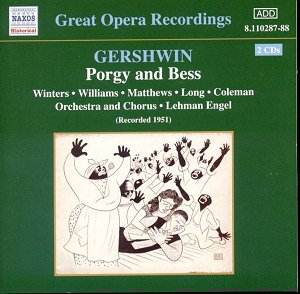|

BUY NOW
Crotchet
AmazonUK
AmazonUS
|
George
GERSHWIN (1898-1937)
Porgy and Bess - Opera in Three
Acts (1935) (Abbreviated version)
Lyrics by DuBose Heyward and Ira Gershwin. Libretto
by DuBose Heyward.
Porgy, Lawrence Winters (bar); Bess, Camilla
Williams (sop); Serena, Inez Matthews (sop);
Sporting Life, Avon Long (ten); Crown, Warren
Coleman (bar); Clara, June McMechen (sop); Maria/Lily/Strawberry
Woman, Helen Dowdy (mezzo); Jake, Eddie Matthews
(bar); Mingo, William A. Glover (ten); Robbins,
Irving Washington (ten); Peter, Harrison Cattenhead
(ten); Frazier, J. Rosamond Johnson (bar); Annie,
Sadie McGill (mezzo); Jim, George Fisher (bar);
Undertaker, Hubert Dilworth (bar); Nelson/Crab
Man, Ray Yeats (Tenor)
 Orchestra and J. Rosamond Johnson Chorus/Lehman
Engel
Orchestra and J. Rosamond Johnson Chorus/Lehman
Engel
Recorded 5th-13th April 1951 in the Columbia
30th Street Studios, New York
Appendix. Highlights from Porgy
and Bess
Risë Stevens (mezzo); Robert
Merrill (bar)
The Robert Shaw Chorale. RCA Victor Orchestra/Robert
Russell Bennett
Reissue Producer and Restoration Engineer: Mark
Obert-Thorn
 NAXOS HISTORICAL GREAT OPERA RECORDINGS 8.110287-88
[2CDs: 77.36+79.09]
NAXOS HISTORICAL GREAT OPERA RECORDINGS 8.110287-88
[2CDs: 77.36+79.09]
|

